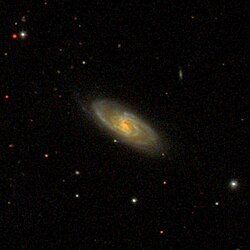NGC 716
Spiral galaxy in the constellation Aries From Wikipedia, the free encyclopedia
NGC 716 is a large barred spiral galaxy located in the constellation Aries,[4] about 200 million light-years away from the Milky Way. The luminosity class of NGC 716 is I and has a large HI line.[5] It also contains regions of ionized hydrogen. Many non-redshift measurements provide a distance of 54,023±8,169 Mpc (~176 million light years), which is within the distances calculated using the redshift value.[6]
| NGC 716 | |
|---|---|
 SDSS image of NGC 716 | |
| Observation data (J2000 epoch) | |
| Constellation | Aries |
| Right ascension | 01h 52m 59.65476s[1] |
| Declination | +12° 42′ 30.6934″[1] |
| Redshift | 0.015409[2] |
| Heliocentric radial velocity | 4584 km/s[2] |
| Distance | 174.66 ± 7.86 Mly (53.55 ± 2.409 Mpc)[3] |
| Apparent magnitude (B) | 14.0[2] |
| Characteristics | |
| Type | SBa?[3] |
| Other designations | |
| IC 1743, UGC 1351, MCG +02-05-054, PGC 6982[2] | |
History
NGC 716 was discovered in 1886 by American astronomer Lewis Swift using a 40.64 cm (16 inch) optical telescope that used a mirror as a light-gathering element. It was also observed by the French astronomer Guillaume Bigourdan on 1 January 1892 and was added to the Index Catalog with the code IC 1743.
References
See also
External links
Wikiwand - on
Seamless Wikipedia browsing. On steroids.
